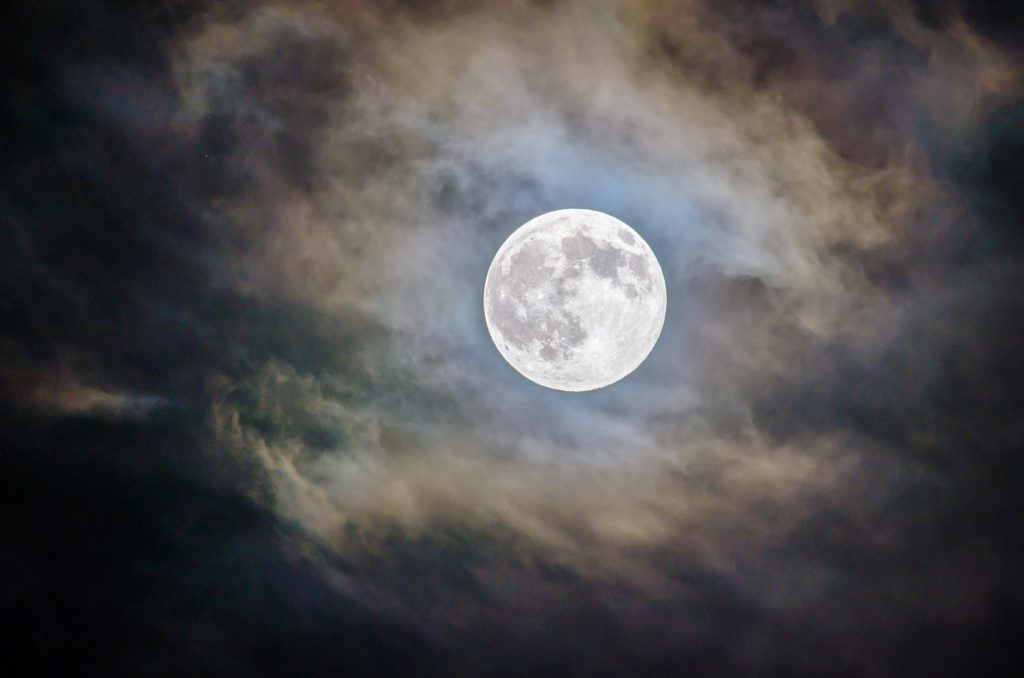Why do traditional Mysore style Ashtanga Yoga programs cancel classes during the new and full moon days?
The many phases of the moon cycle are determined by the moon’s position to the sun. A full moon occurs when the sun and moon are in complete opposition to each other. In contrast, a new moon occurs when the sun and moon are in total conjunction to each other. The sun and moon both exert a tremendous gravitational pull on the earth, and at the same time, every human being on earth.
Keep in mind that the human body is comprised 60-75% of water. We are similar to the earth, which is made up of 71% water. And like all things of a watery nature, we mortals are sensitively affected by the phases of the moon. Like the earth, the sun and moon exert a gravitational pull on our own individual bodies too. The positions of the sun and moon create various different energetic experiences that we can feel in our body. Many yogic traditions compare these energetic experiences to that of a breath cycle, or an inhale and an exhale.

The Moons Energy
The energy of a full moon can be compared to the very end of an inhalation. That is the point when the force of prana (life force energy) is highest. This kind of upward moving, expansive energy can make us feel both energetic and emotional. However, that energy is not well rooted or grounded. According to the Upanishads, the primary prana resides in the head and during the full moon humans thus tend to be more headstrong. In contrast, the energy of a new moon is often compared to the end of an exhale, the point when the force of apana (downward flowing life force energy) is greatest. Apana is a downward moving force that contracts and helps us to feel grounded and calm. However, the force is dense and the energy wants to be exerted.
According to the Farmers Almanac, it is ideal to plant seeds at the time of the new moon. This is when the rooting force is strongest. The Farmers Almanac also suggests we transplant the seeds at the full moon. That is when the flowering force is greatest. If you look at nature closely, you can begin to observe the effects of the moon cycle on all living things. The more frequently you connect with nature, the more keen your observation becomes of such natural cycles. And the same goes for practicing Ashtanga Yoga. Practicing Ashtanga Yoga consistently, over time, helps us become more aware of these natural cycles. And by observing the moon days we are able to create a greater connection and awareness to these rhythms of nature. That enables us to live in greater harmony with it.

Honoring the Ashtanga Tradition
When you first begin this practice, you may not understand the importance of taking rest on the moon days. Connect to the tradition and embrace the experience. In time, you will come to treasure these days of rest from practice. Correspondingly, you will notice that your body and mind are not as sharp during the new and full moon, and more prone to accidents. As you become more aware of the moon cycles, you will notice your mind can be erratic jumping more quickly from thought to thought. You will notice less connection to your breathing and your bandhas, less connection to the energy in your body. And if you do a traditional 6 day per week asana practice, your body will appreciate these days of rest each month.
Instead of doing asana on the new and full moon, create moon day rituals you can enjoy instead of yoga asana on these special days of the month. My personal moon day rituals include waking at the same time I usually do for yoga asana practice, but instead of movement I devote that time to meditation and journaling. I work with the energy of the moon phase to work on mindset, manifestation, goal setting and connection. I meditate on the energy of the moon and deepen my connection to all life force energies. And when I finish journaling and meditation, I take a long walk in nature to more fully connect to this energy in and around me.
Tap here to learn about this years new and full moon days.
Namaste




